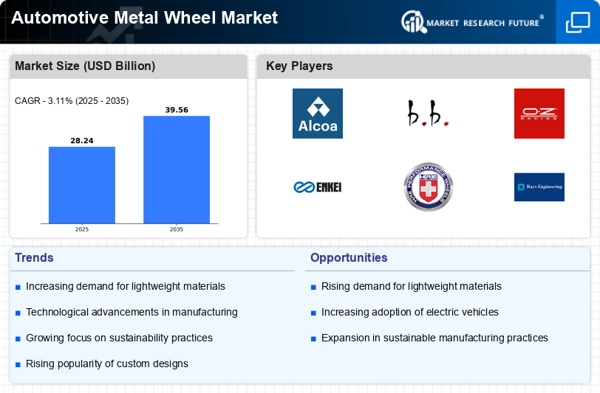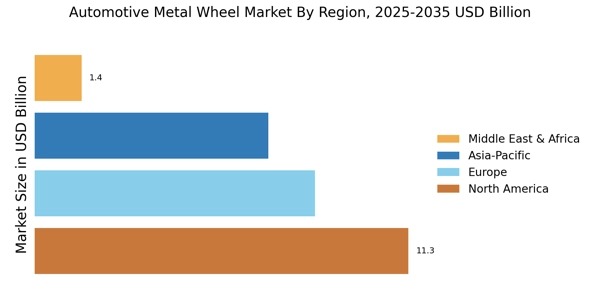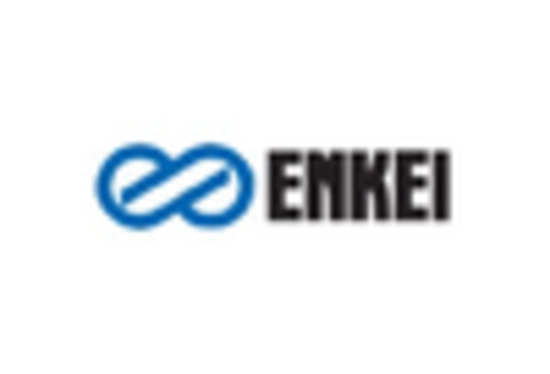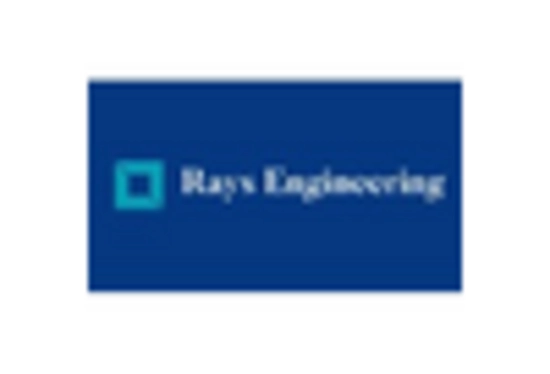Growth of Aftermarket Services
The Automotive Metal Wheel Market is benefiting from the expansion of aftermarket services, which include wheel customization, repair, and replacement. As vehicle owners increasingly seek personalized options for their vehicles, the demand for unique and high-quality metal wheels is on the rise. This trend is particularly evident in the growing popularity of alloy wheels, which offer aesthetic appeal and performance benefits. The aftermarket segment is projected to grow at a CAGR of approximately 6% over the next few years, driven by consumer preferences for customization and enhanced vehicle performance. Additionally, the rise of online retail platforms facilitates easier access to a variety of metal wheel options, further stimulating growth in the Automotive Metal Wheel Market.
Sustainability and Eco-Friendly Practices
The Automotive Metal Wheel Market is increasingly influenced by sustainability and eco-friendly practices. As environmental concerns gain prominence, manufacturers are exploring ways to reduce their carbon footprint and enhance the recyclability of metal wheels. The use of recycled materials in wheel production not only aligns with sustainability goals but also appeals to environmentally conscious consumers. Furthermore, the shift towards electric vehicles, which often require lightweight components for improved efficiency, is likely to drive demand for sustainable metal wheels. This trend may lead to innovations in material science and manufacturing processes, fostering a more sustainable Automotive Metal Wheel Market. Analysts predict that the market for eco-friendly wheels could expand significantly, potentially capturing a larger share of the overall market.
Technological Advancements in Manufacturing
The Automotive Metal Wheel Market is experiencing a notable transformation due to advancements in manufacturing technologies. Innovations such as computer-aided design (CAD) and automated production processes enhance precision and efficiency in wheel production. These technologies not only reduce manufacturing costs but also improve the quality and durability of metal wheels. As a result, manufacturers can produce lighter and stronger wheels, which are increasingly demanded by automotive manufacturers. The integration of advanced materials, such as aluminum alloys, further supports this trend, as they offer superior performance characteristics. The market is projected to grow as these technologies become more widely adopted, potentially leading to a compound annual growth rate (CAGR) of around 5% over the next few years.
Regulatory Standards and Safety Requirements
The Automotive Metal Wheel Market is also shaped by stringent regulatory standards and safety requirements imposed by various authorities. These regulations often mandate specific performance criteria for wheels, including strength, durability, and resistance to corrosion. Compliance with these standards is essential for manufacturers to ensure the safety and reliability of their products. As automotive safety becomes a paramount concern, the demand for high-quality metal wheels that meet or exceed these regulations is likely to increase. This trend may lead to a consolidation of manufacturers who can invest in quality assurance processes and advanced testing methods. The market could witness a shift towards premium products that align with these regulatory demands, potentially increasing the overall market value.
Increasing Demand for High-Performance Vehicles
The Automotive Metal Wheel Market is significantly influenced by the rising demand for high-performance vehicles. As consumers increasingly seek vehicles that offer enhanced speed, handling, and aesthetics, manufacturers are compelled to invest in high-quality metal wheels that meet these expectations. High-performance vehicles often require specialized wheels that can withstand greater stress and provide improved traction. This trend is reflected in the growing sales of premium and luxury vehicles, which are expected to account for a larger share of the automotive market. Consequently, the demand for lightweight and durable metal wheels is likely to surge, driving growth in the Automotive Metal Wheel Market. Analysts suggest that this segment could see an increase in market share by approximately 10% in the coming years.


















Leave a Comment